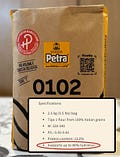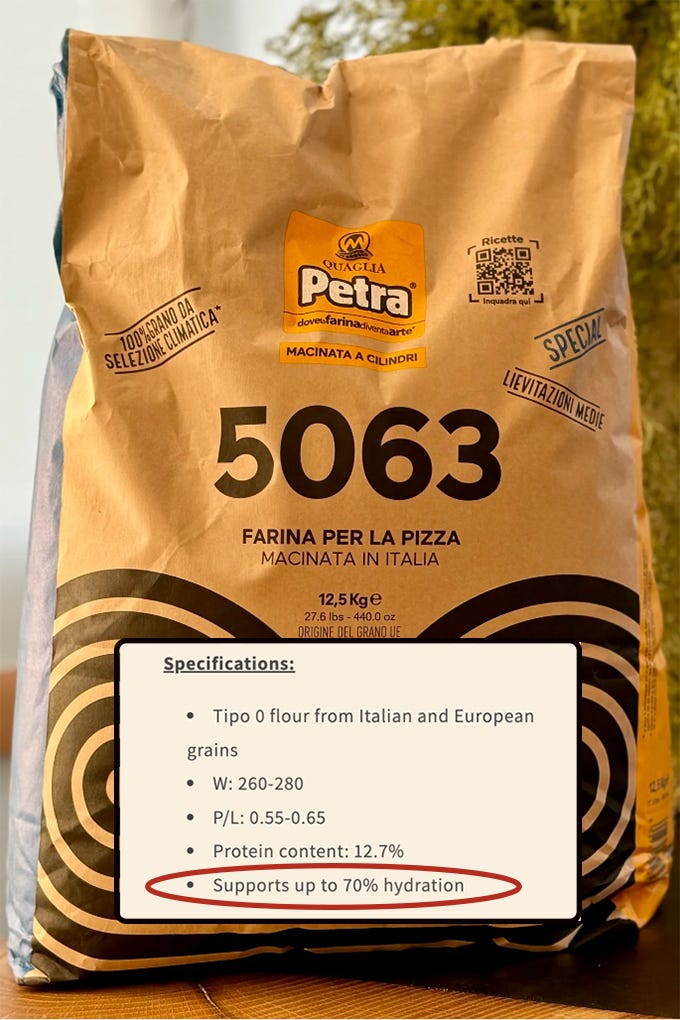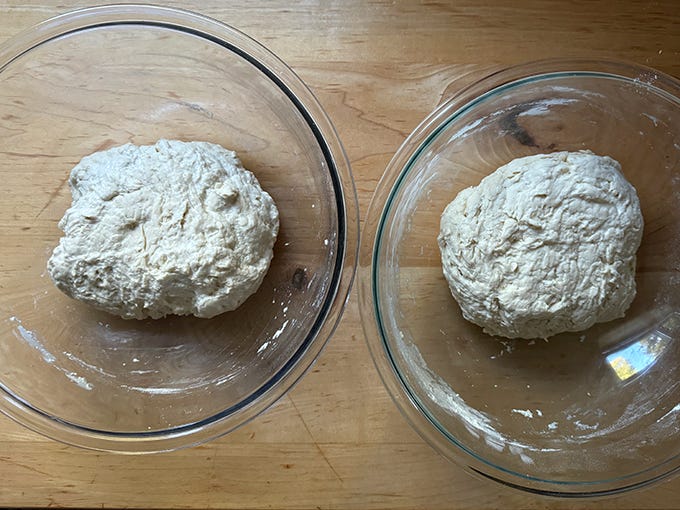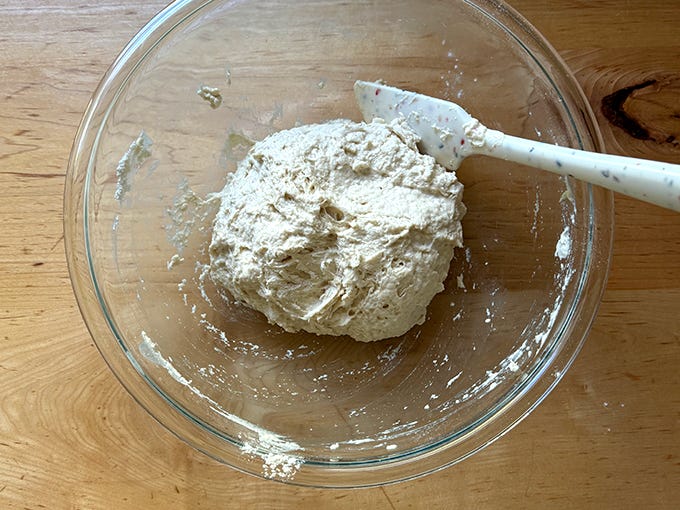Pizza Friends, hello! And happy Friday.
A few weeks ago, while on the Brick Oven Baker website researching Petra 0102 flour, I spotted a detail I had never before seen in a list of flour specs. It said:
Supports up to 80% hydration
Interesting I thought. So I clicked over to the Petra 5063 product page and looked up the specs there, which said:
Supports up to 70% hydration
How helpful?! I thought. Why? Let’s back up:
If you are new here, I started experimenting with Petra flour a few months ago upon being disappointed with the 00 flour I had been using for years. I started with the Petra 0102, which is made with partially sprouted wheat flour and which I wrote about here, and then moved on to the Petra 5063, which is designed for outdoor ovens and which behaves more like the 00 flours I am familiar with but so much better. I wrote about that here. I love them both.
One thing I observed about dough made with each of these flours is that it is slightly wetter than dough made with bread flour. It’s not unmanageable, but in recent weeks, when I’ve been making Neapolitan-style dough for my outdoor oven using the Petra flours, I’ve reduced the hydration slightly (to 68% from 70%), and I’m getting even better results (more on this soon).
Why is this important? Well, as I’ve contemplated using the Petra flours for Neapolitan-style pizza in my indoor oven, I’ve wondered how they will perform. I would have to increase the water — remember: using a higher hydration dough is one key to having success when baking pizza in a home oven (see #3 in this post).
And as I thought about making this dough, which is 77% hydration, I worried about it being a sticky mess. Until that is, I saw those specs!
If they were accurate, the dough made with the Petra 0102 would be fine and the dough made with Petra 5063 would not. And so I set out to experiment. I mixed one batch of dough with the Petra 0102 (on the left below) and one with King Arthur Flour bread flour (on the right below):
And I mixed one batch of dough with the Petra 5063:
It is hard to discern from the photos, but as expected the dough made with Petra 5063 at 77% hydration is unmanageably sticky. (I fixed it by adding more flour and salt.) The dough made with the Petra 0102 is slightly wetter than the one made with bread flour, but not unmanageably so.
Again, why am I sharing all of this with you? Well, because if all flour companies included the hydration spec on their flour bags, bakers across the world could save themselves so much trouble.
Having troubleshooted with many people over the years from Canada and the UK as well as other parts of Europe, I’ve learned that the ratio of water I use given the flour I use is often too high for these bakers.
These bakers will write me saying, “I am using strong bread flour with 12.7% protein content and my dough is a soupy mess. I weighed all of the ingredients in grams. Are you sure your water amount is accurate?”
It is! But two flours with the same protein content don’t necessarily absorb water the same way. For these bakers to have success with my recipes given the flours they are using, often they have to reduce the water considerably.
In the US, I’ve found that most bread flours as well as all-purpose flours across brands behave mostly similarly in the way they absorb water, but I’d still love to see that spec on every bag of flour I pick up — it’s as helpful if not more so than knowing the protein content.
Anyway, Friends, that’s all I’ve got today. But I do have plenty of Petra dough balls on hand, which I will be baking in my home oven over the next few days and will be sharing the results with all of you shortly. I am headed to Nashville next Friday, however, for Pizza Fest, so if I don’t get around to posting the results before I leave, I will report back in two weeks.
I hope all is well! Let me know if you have any questions 🍕🍕🍕🍕🍕
Nashville Friends?
On October 19th — next weekend! — at 3 pm, I’ll be doing a “Pizza at Home” demo at Pizza City Fest Nashville. Comedian AJ Jacobs will be moderating the demo, and if you live nearby, I’d love to meet you! The lineup of pizza vendors all weekend looks incredible, and on Sunday, one of my pizza heroes, Justin de Leon of Appolonia’s Pizzeria in Los Angeles, is doing a pan pizza demo. His pizza is insanely delicious. Get your tickets here!
Love pizza and salad? (And dessert?!) Find recipes, tips, and tricks in Pizza Night 🍕🍕🥗🥗
Amazon | Barnes and Noble | Books-a-Million | Bookshop.org | Hudson Booksellers | Walmart










When using a new flour I set out six little dishes and mix up 75, 80, 85, 90, 95, and 100% hydrations, let sit for 20-30 minutes, then see how each behaves when manipulated. One bad experience with under-hydrated dough was enough.
Ali, this is fascinating…what a great find! As I’m learning more about pizza and bread doughs, I feel very lucky as a reader to be the beneficiary of your experiments and points of learning.
(Also, my Challenger bread pan is on the way, I’ve got extra pizza dough in the fridge, and I’ll be making baguettes with it SO soon! 🥳)